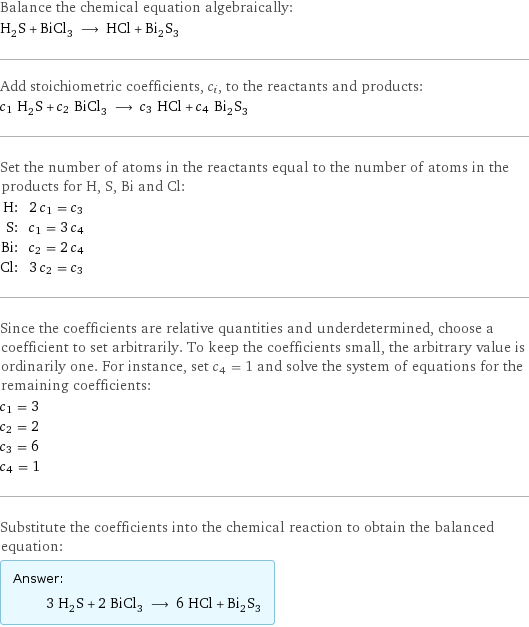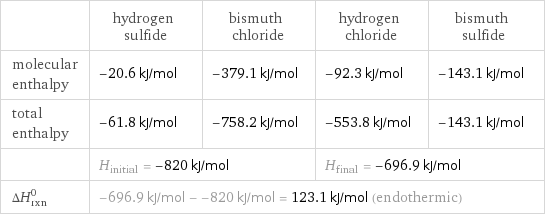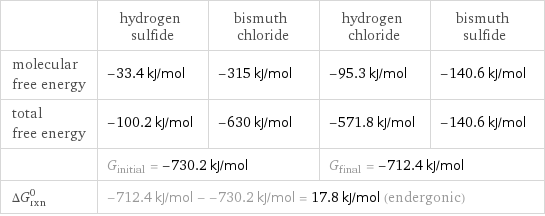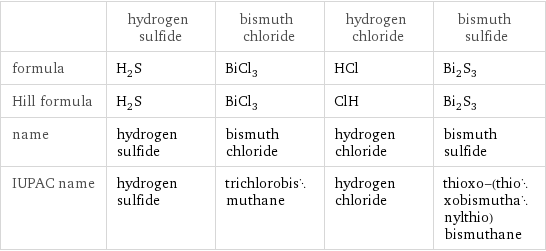Input interpretation

H_2S hydrogen sulfide + BiCl_3 bismuth chloride ⟶ HCl hydrogen chloride + Bi_2S_3 bismuth sulfide
Balanced equation

Balance the chemical equation algebraically: H_2S + BiCl_3 ⟶ HCl + Bi_2S_3 Add stoichiometric coefficients, c_i, to the reactants and products: c_1 H_2S + c_2 BiCl_3 ⟶ c_3 HCl + c_4 Bi_2S_3 Set the number of atoms in the reactants equal to the number of atoms in the products for H, S, Bi and Cl: H: | 2 c_1 = c_3 S: | c_1 = 3 c_4 Bi: | c_2 = 2 c_4 Cl: | 3 c_2 = c_3 Since the coefficients are relative quantities and underdetermined, choose a coefficient to set arbitrarily. To keep the coefficients small, the arbitrary value is ordinarily one. For instance, set c_4 = 1 and solve the system of equations for the remaining coefficients: c_1 = 3 c_2 = 2 c_3 = 6 c_4 = 1 Substitute the coefficients into the chemical reaction to obtain the balanced equation: Answer: | | 3 H_2S + 2 BiCl_3 ⟶ 6 HCl + Bi_2S_3
Structures

+ ⟶ +
Names

hydrogen sulfide + bismuth chloride ⟶ hydrogen chloride + bismuth sulfide
Reaction thermodynamics
Enthalpy

| hydrogen sulfide | bismuth chloride | hydrogen chloride | bismuth sulfide molecular enthalpy | -20.6 kJ/mol | -379.1 kJ/mol | -92.3 kJ/mol | -143.1 kJ/mol total enthalpy | -61.8 kJ/mol | -758.2 kJ/mol | -553.8 kJ/mol | -143.1 kJ/mol | H_initial = -820 kJ/mol | | H_final = -696.9 kJ/mol | ΔH_rxn^0 | -696.9 kJ/mol - -820 kJ/mol = 123.1 kJ/mol (endothermic) | | |
Gibbs free energy

| hydrogen sulfide | bismuth chloride | hydrogen chloride | bismuth sulfide molecular free energy | -33.4 kJ/mol | -315 kJ/mol | -95.3 kJ/mol | -140.6 kJ/mol total free energy | -100.2 kJ/mol | -630 kJ/mol | -571.8 kJ/mol | -140.6 kJ/mol | G_initial = -730.2 kJ/mol | | G_final = -712.4 kJ/mol | ΔG_rxn^0 | -712.4 kJ/mol - -730.2 kJ/mol = 17.8 kJ/mol (endergonic) | | |
Equilibrium constant
![Construct the equilibrium constant, K, expression for: H_2S + BiCl_3 ⟶ HCl + Bi_2S_3 Plan: • Balance the chemical equation. • Determine the stoichiometric numbers. • Assemble the activity expression for each chemical species. • Use the activity expressions to build the equilibrium constant expression. Write the balanced chemical equation: 3 H_2S + 2 BiCl_3 ⟶ 6 HCl + Bi_2S_3 Assign stoichiometric numbers, ν_i, using the stoichiometric coefficients, c_i, from the balanced chemical equation in the following manner: ν_i = -c_i for reactants and ν_i = c_i for products: chemical species | c_i | ν_i H_2S | 3 | -3 BiCl_3 | 2 | -2 HCl | 6 | 6 Bi_2S_3 | 1 | 1 Assemble the activity expressions accounting for the state of matter and ν_i: chemical species | c_i | ν_i | activity expression H_2S | 3 | -3 | ([H2S])^(-3) BiCl_3 | 2 | -2 | ([BiCl3])^(-2) HCl | 6 | 6 | ([HCl])^6 Bi_2S_3 | 1 | 1 | [Bi2S3] The equilibrium constant symbol in the concentration basis is: K_c Mulitply the activity expressions to arrive at the K_c expression: Answer: | | K_c = ([H2S])^(-3) ([BiCl3])^(-2) ([HCl])^6 [Bi2S3] = (([HCl])^6 [Bi2S3])/(([H2S])^3 ([BiCl3])^2)](../image_source/2bbac1aa1aa349a6f3509826b4941568.png)
Construct the equilibrium constant, K, expression for: H_2S + BiCl_3 ⟶ HCl + Bi_2S_3 Plan: • Balance the chemical equation. • Determine the stoichiometric numbers. • Assemble the activity expression for each chemical species. • Use the activity expressions to build the equilibrium constant expression. Write the balanced chemical equation: 3 H_2S + 2 BiCl_3 ⟶ 6 HCl + Bi_2S_3 Assign stoichiometric numbers, ν_i, using the stoichiometric coefficients, c_i, from the balanced chemical equation in the following manner: ν_i = -c_i for reactants and ν_i = c_i for products: chemical species | c_i | ν_i H_2S | 3 | -3 BiCl_3 | 2 | -2 HCl | 6 | 6 Bi_2S_3 | 1 | 1 Assemble the activity expressions accounting for the state of matter and ν_i: chemical species | c_i | ν_i | activity expression H_2S | 3 | -3 | ([H2S])^(-3) BiCl_3 | 2 | -2 | ([BiCl3])^(-2) HCl | 6 | 6 | ([HCl])^6 Bi_2S_3 | 1 | 1 | [Bi2S3] The equilibrium constant symbol in the concentration basis is: K_c Mulitply the activity expressions to arrive at the K_c expression: Answer: | | K_c = ([H2S])^(-3) ([BiCl3])^(-2) ([HCl])^6 [Bi2S3] = (([HCl])^6 [Bi2S3])/(([H2S])^3 ([BiCl3])^2)
Rate of reaction
![Construct the rate of reaction expression for: H_2S + BiCl_3 ⟶ HCl + Bi_2S_3 Plan: • Balance the chemical equation. • Determine the stoichiometric numbers. • Assemble the rate term for each chemical species. • Write the rate of reaction expression. Write the balanced chemical equation: 3 H_2S + 2 BiCl_3 ⟶ 6 HCl + Bi_2S_3 Assign stoichiometric numbers, ν_i, using the stoichiometric coefficients, c_i, from the balanced chemical equation in the following manner: ν_i = -c_i for reactants and ν_i = c_i for products: chemical species | c_i | ν_i H_2S | 3 | -3 BiCl_3 | 2 | -2 HCl | 6 | 6 Bi_2S_3 | 1 | 1 The rate term for each chemical species, B_i, is 1/ν_i(Δ[B_i])/(Δt) where [B_i] is the amount concentration and t is time: chemical species | c_i | ν_i | rate term H_2S | 3 | -3 | -1/3 (Δ[H2S])/(Δt) BiCl_3 | 2 | -2 | -1/2 (Δ[BiCl3])/(Δt) HCl | 6 | 6 | 1/6 (Δ[HCl])/(Δt) Bi_2S_3 | 1 | 1 | (Δ[Bi2S3])/(Δt) (for infinitesimal rate of change, replace Δ with d) Set the rate terms equal to each other to arrive at the rate expression: Answer: | | rate = -1/3 (Δ[H2S])/(Δt) = -1/2 (Δ[BiCl3])/(Δt) = 1/6 (Δ[HCl])/(Δt) = (Δ[Bi2S3])/(Δt) (assuming constant volume and no accumulation of intermediates or side products)](../image_source/c59eb494d58be00629e560b4f3e725f2.png)
Construct the rate of reaction expression for: H_2S + BiCl_3 ⟶ HCl + Bi_2S_3 Plan: • Balance the chemical equation. • Determine the stoichiometric numbers. • Assemble the rate term for each chemical species. • Write the rate of reaction expression. Write the balanced chemical equation: 3 H_2S + 2 BiCl_3 ⟶ 6 HCl + Bi_2S_3 Assign stoichiometric numbers, ν_i, using the stoichiometric coefficients, c_i, from the balanced chemical equation in the following manner: ν_i = -c_i for reactants and ν_i = c_i for products: chemical species | c_i | ν_i H_2S | 3 | -3 BiCl_3 | 2 | -2 HCl | 6 | 6 Bi_2S_3 | 1 | 1 The rate term for each chemical species, B_i, is 1/ν_i(Δ[B_i])/(Δt) where [B_i] is the amount concentration and t is time: chemical species | c_i | ν_i | rate term H_2S | 3 | -3 | -1/3 (Δ[H2S])/(Δt) BiCl_3 | 2 | -2 | -1/2 (Δ[BiCl3])/(Δt) HCl | 6 | 6 | 1/6 (Δ[HCl])/(Δt) Bi_2S_3 | 1 | 1 | (Δ[Bi2S3])/(Δt) (for infinitesimal rate of change, replace Δ with d) Set the rate terms equal to each other to arrive at the rate expression: Answer: | | rate = -1/3 (Δ[H2S])/(Δt) = -1/2 (Δ[BiCl3])/(Δt) = 1/6 (Δ[HCl])/(Δt) = (Δ[Bi2S3])/(Δt) (assuming constant volume and no accumulation of intermediates or side products)
Chemical names and formulas

| hydrogen sulfide | bismuth chloride | hydrogen chloride | bismuth sulfide formula | H_2S | BiCl_3 | HCl | Bi_2S_3 Hill formula | H_2S | BiCl_3 | ClH | Bi_2S_3 name | hydrogen sulfide | bismuth chloride | hydrogen chloride | bismuth sulfide IUPAC name | hydrogen sulfide | trichlorobismuthane | hydrogen chloride | thioxo-(thioxobismuthanylthio)bismuthane
Substance properties

| hydrogen sulfide | bismuth chloride | hydrogen chloride | bismuth sulfide molar mass | 34.08 g/mol | 315.3 g/mol | 36.46 g/mol | 514.14 g/mol phase | gas (at STP) | solid (at STP) | gas (at STP) | solid (at STP) melting point | -85 °C | 231 °C | -114.17 °C | 763 °C boiling point | -60 °C | 447 °C | -85 °C | density | 0.001393 g/cm^3 (at 25 °C) | 4.75 g/cm^3 | 0.00149 g/cm^3 (at 25 °C) | 7.7 g/cm^3 solubility in water | | | miscible | insoluble dynamic viscosity | 1.239×10^-5 Pa s (at 25 °C) | 41 Pa s (at 25 °C) | |
Units
